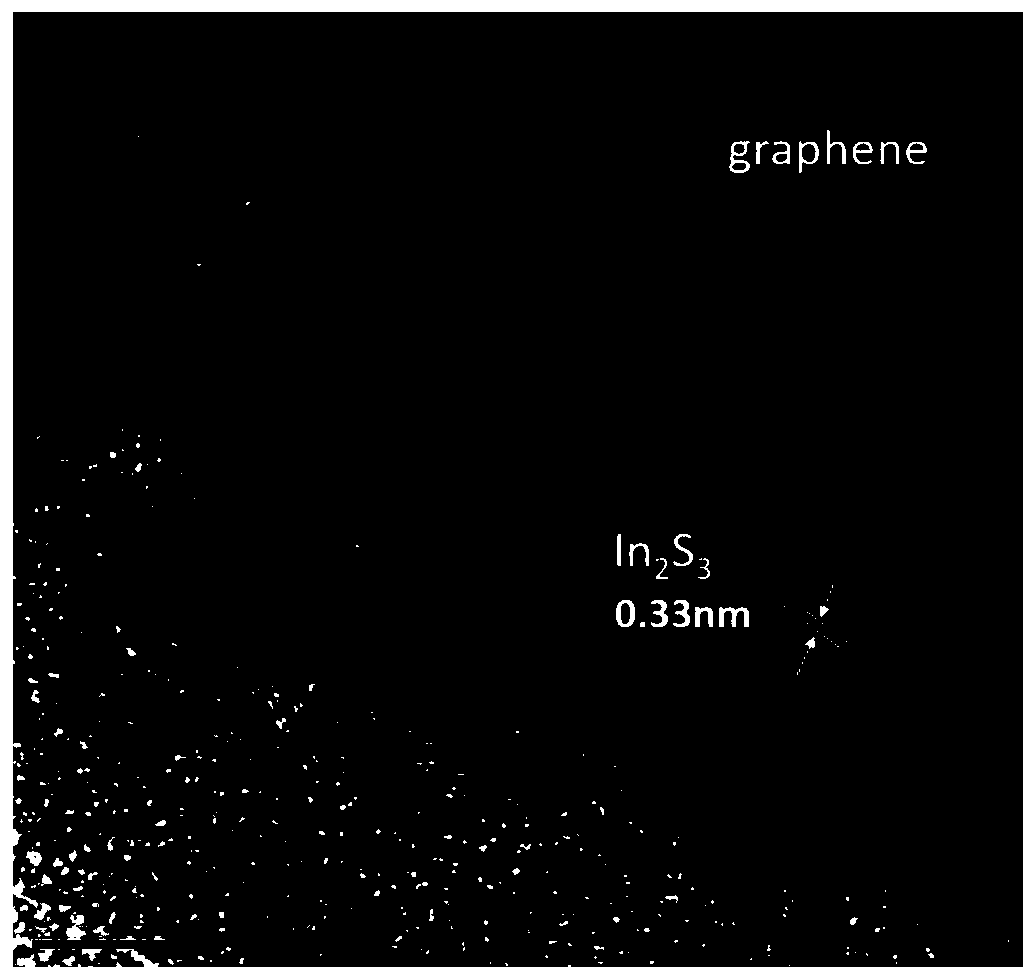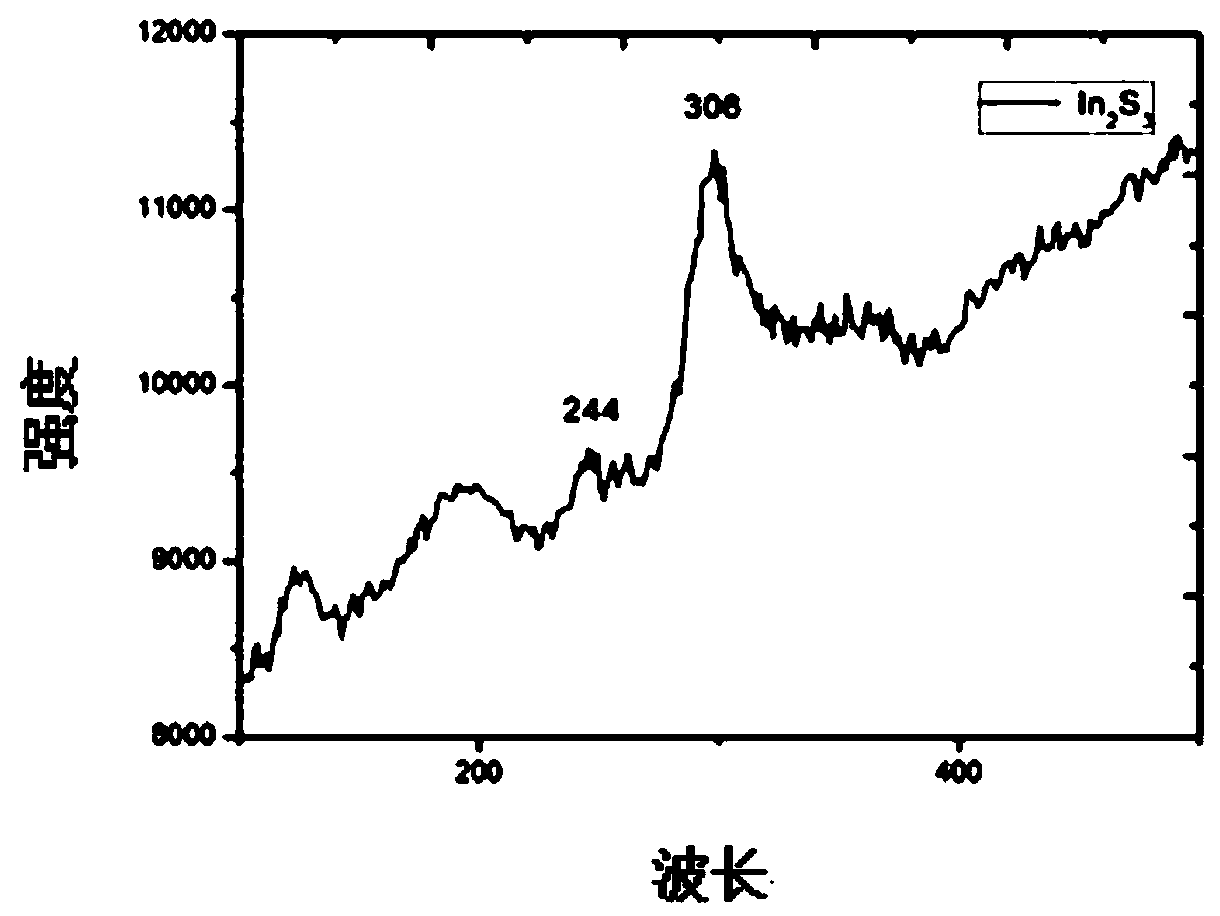Indium sulfide/graphene composite film, and preparation method and application thereof
A graphene composite, indium sulfide technology, applied in chemical instruments and methods, chemical/physical processes, electrochemical generators, etc., can solve the problems of indium sulfide thin film limitation, long reaction time, high solvent toxicity, etc. Chemical properties, low cost, and the effect of improving electrical conductivity
- Summary
- Abstract
- Description
- Claims
- Application Information
AI Technical Summary
Problems solved by technology
Method used
Image
Examples
Embodiment 1
[0029] 1. Prepare 40 ml of ethyl cellulose ethanol solution with a mass fraction of 10 wt%, and then add 10 g of terpineol. Then add the prepared 0.1g graphene powder. Stir magnetically for 2h. Stir again and evaporate absolute ethanol to dryness. Then add 0.6ml acetylacetone and 0.6ml OP emulsifier and stir evenly to obtain graphene slurry.
[0030] 2. Use the spin coating method to coat the graphene slurry on the cleaned FTO glass conductive surface, and place it in a blast drying oven at 80°C for 20 minutes for pretreatment. Then repeat the above steps to print 6 times, and the printed graphene paste is finally sintered in a muffle furnace at 300°C at different temperatures;
[0031] 3. Add 0.1mmol of indium chloride and 0.1mmol of thiourea to 60ml of ethylene glycol in turn, and magnetically stir until fully dissolved to obtain a reaction precursor solution;
[0032] 4. Put the FTO conductive glass prepared with the graphene film into a three-necked flask with the cond...
Embodiment 2
[0034] 1. Prepare 40 ml of ethyl cellulose ethanol solution with a mass fraction of 10 wt%, and then add 10 g of terpineol. Then add the prepared 0.1g graphene powder. Stir magnetically for 2h. Stir again and evaporate absolute ethanol to dryness. Then add 0.6ml acetylacetone and 0.6ml OP emulsifier and stir evenly to obtain graphene slurry.
[0035] 2. Use the screen printing method to print graphene paste on the cleaned conductive surface of FTO glass, and place it in a blast drying oven at 120°C for 20 minutes for pretreatment. Then repeat the above steps to print 6 times, and the printed graphene paste is finally sintered in a muffle furnace at 400°C at different temperatures;
[0036] 5. Add 0.5mmol of indium chloride and 0.5mmol of thiourea to 60ml of ethylene glycol in sequence, then add 0.25g of PVP, and magnetically stir until fully dissolved to obtain a reaction precursor solution;
[0037] 6. Put the FTO conductive glass prepared with the graphene film into a th...
Embodiment 3
[0040] 1. Prepare 40 ml of ethyl cellulose ethanol solution with a mass fraction of 10 wt%, and then add 10 g of terpineol. Then add the prepared 0.2g graphene powder, magnetically stir for 4h, then stir and evaporate absolute ethanol to dryness, then add 0.6ml acetylacetone and 0.6ml OP emulsifier and stir evenly to obtain graphene slurry.
[0041] 2. Use the screen printing method to print graphene paste on the cleaned conductive surface of FTO glass, and place it in a blast drying oven for pretreatment at 100°C for 20 minutes. Then repeat the above steps and print 6 times. The printed graphene paste is finally sintered in a muffle furnace at 350°C at different temperatures;
[0042] 3. Add 0.2mmol of indium chloride and 0.2mmol of thiourea to 60ml of ethylene glycol in sequence, then add 0.25mmol of PVP, and magnetically stir until fully dissolved to obtain a reaction precursor solution;
[0043] 4. Put the FTO conductive glass prepared with the graphene film into a three...
PUM
 Login to View More
Login to View More Abstract
Description
Claims
Application Information
 Login to View More
Login to View More - R&D
- Intellectual Property
- Life Sciences
- Materials
- Tech Scout
- Unparalleled Data Quality
- Higher Quality Content
- 60% Fewer Hallucinations
Browse by: Latest US Patents, China's latest patents, Technical Efficacy Thesaurus, Application Domain, Technology Topic, Popular Technical Reports.
© 2025 PatSnap. All rights reserved.Legal|Privacy policy|Modern Slavery Act Transparency Statement|Sitemap|About US| Contact US: help@patsnap.com



